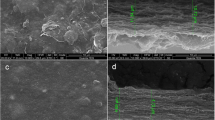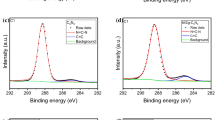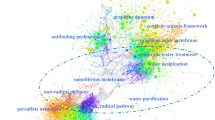Abstract
Oxidation of organic pollutants by sulfate radicals produced via activation of persulfate has emerged as a promising advanced oxidation technology to address various challenging environmental issues. The development of an effective, environmentally-friendly, metal-free catalyst is the key to this technology. Additionally, a supported catalyst design is more advantageous than conventional suspended powder catalysts from the point of view of mass transfer and practical engineering applications (e.g. post-use separation). In this study, a metal-free N-doped reduced graphene oxide (N-rGO) catalyst was prepared via a facile hydrothermal method. N-rGO filters were then synthesized by facile vacuum filtration, such that water can flow through nanochannels within the filters. Various advanced characterization techniques were employed to obtain structural and compositional information of the as-synthesized N-rGO filters. An optimized phenol oxidative flux of 0.036 ± 0.002 mmol·h–1 was obtained by metal-free catalytic activation of persulfate at an influent persulfate concentration of 1.0 mmol·L–1 and filter weight of 15 mg, while a N-free rGO filter demonstrated negligible phenol oxidation capability under similar conditions. Compared to a conventional batch system, the flow-through design demonstrates obviously enhanced oxidation kinetics (0.036 vs. 0.010 mmol·h–1), mainly due to the liquid flow through the filter leading to convection-enhanced transfer of the target molecule to the filter active sites. Overall, the results exemplified the advantages of organic compound removal by catalytic activation of persulfate using a metal-free catalyst in flowthrough mode, and demonstrated the potential of N-rGO filters for practical environmental applications.

Similar content being viewed by others
References
Michalowicz, J.; Duda, W. Phenols—Sources and toxicity. Pol. J. Environ. Stud. 2007, 16, 347–362.
Hladik, M. L.; Focazio, M. J.; Engle, M. Discharges of produced waters from oil and gas extraction via wastewater treatment plants are sources of disinfection by-products to receiving streams. Sci. Total Environ. 2014, 466–467, 1085–1093.
Mukherjee, R.; De, S. Adsorptive removal of phenolic compounds using cellulose acetate phthalate-alumina nanoparticle mixed matrix membrane. J. Hazard. Mater. 2014, 265, 8–19.
Zhang, A.; Li, Y. M. Removal of phenolic endocrine disrupting compounds from waste activated sludge using UV, H2O2, and UV/H2O2 oxidation processes: Effects of reaction conditions and sludge matrix. Sci. Total Environ. 2014, 493, 307–323.
Al Hashemi, W.; Maraqa, M. A.; Rao, M. V.; Hossain, M. M. Characterization and removal of phenolic compounds from condensate-oil refinery wastewater. Desalin. Water Treat. 2015, 54, 660–671.
Iboukhoulef, H.; Amrane, A.; Kadi, H. Removal of phenolic compounds from olive mill wastewater by a Fenton-like system H2O2/Cu(II)—Thermodynamic and kinetic modeling. Desalin. Water Treat. 2016, 57, 1874–1879.
Adhoum, N.; Monser, L. Decolourization and removal of phenolic compounds from olive mill wastewater by electrocoagulation. Chem. Eng. Process. 2004, 43, 1281–1287.
Achak, M.; Hafidi, A.; Ouazzani, N.; Sayadi, S.; Mandi, L. Low cost biosorbent “banana peel” for the removal of phenolic compounds from olive mill wastewater: Kinetic and equilibrium studies. J. Hazard. Mater. 2009, 166, 117–125.
Ersöz, A.; Denizli, A.; Sener, I.; Atilir, A.; Diltemiz, S.; Say, R. Removal of phenolic compounds with nitrophenolimprinted polymer based on p–p and hydrogen-bonding interactions. Sep. Purif. Technol. 2004, 38, 173–179.
Caza, N.; Bewtra, J. K.; Biswas, N.; Taylor, K. E. Removal of phenolic compounds from synthetic wastewater using soybean peroxidase. Water Res. 1999, 33, 3012–3018.
Subramani, A.; Jacangelo, J. G. Emerging desalination technologies for water treatment: A critical review. Water Res. 2015, 75, 164–187.
Saitoh, T.; Fukushima, K.; Miwa, A. Combined use of surfactant-induced coagulation of poly(allylamine hydrochloride) with peroxidase-mediated degradation for the rapid removal of estrogens and phenolic compounds from water. Sep. Purif. Technol. 2014, 128, 11–17.
Indrawirawan, S.; Sun, H. Q.; Duan, X. G.; Wang, S. B. Nanocarbons in different structural dimensions (0–3D) for phenol adsorption and metal-free catalytic oxidation. Appl. Catal. B: Environ. 2015, 179, 352–362.
Sun, H. Q.; Liu, S. Z.; Zhou, G. L.; Ang, H. M.; Tadé, M. O.; Wang, S. B. Reduced graphene oxide for catalytic oxidation of aqueous organic pollutants. ACS Appl. Mater. Interfaces 2012, 4, 5466–5471.
Tsitonaki, A.; Petri, B.; Crimi, M.; Mosbæk, H.; Siegrist, R. L.; Bjerg, P. L. In situ chemical oxidation of contaminated soil and groundwater using persulfate: A review. Crit. Rev. Environ. Sci. Technol. 2010, 40, 55–91.
Brillas, E.; Sirés, I.; Oturan, M. A. Electro-fenton process and related electrochemical technologies based on fenton's reaction chemistry. Chem. Rev. 2009, 109, 6570–6631.
Yan, J. C.; Zhu, L. H.; Luo, Z. H.; Huang, Y. F.; Tang, H. Q.; Chen, M. F. Oxidative decomposition of organic pollutants by using persulfate with ferrous hydroxide colloids as efficient heterogeneous activator. Sep. Purif. Technol. 2013, 106, 8–14.
Yan, J. C.; Lei, M.; Zhu, L. H.; Anjum, M. N.; Zou, J.; Tang, H. Q. Degradation of sulfamonomethoxine with Fe3O4 magnetic nanoparticles as heterogeneous activator of persulfate. J. Hazard. Mater. 2011, 186, 1398–1404.
Fang, G. D.; Gao, J.; Dionysiou, D. D.; Liu, C.; Zhou, D. M. Activation of persulfate by quinones: Free radical reactions and implication for the degradation of PCBs. Environ. Sci. Technol. 2013, 47, 4605–4611.
Fang, G. D.; Liu, C.; Gao, J.; Dionysiou, D. D.; Zhou, D. M. Manipulation of persistent free radicals in biochar to activate persulfate for contaminant degradation. Environ. Sci. Technol. 2015, 49, 5645–5653.
Zhong, H.; Brusseau, M. L.; Wang, Y. K.; Yan, N.; Quig, L.; Johnson, G. R. In-situ activation of persulfate by iron filings and degradation of 1,4-dioxane. Water Res. 2015, 83, 104–111.
Gao, Y. W.; Zhang, Z. Y.; Li, S. M.; Liu, J.; Yao, L. Y.; Li, Y. X.; Zhang, H. Insights into the mechanism of heterogeneous activation of persulfate with a clay/iron-based catalyst under visible LED light irradiation. Appl. Catal. B: Environ. 2016, 185, 22–30.
Novoselov, K. S.; Geim, A. K.; Morozov, S. V.; Jiang, D.; Zhang, Y.; Dubonos, S. V.; Grigorieva, I. V.; Firsov, A. A. Electric field effect in atomically thin carbon films. Science 2004, 306, 666–669.
Chen, S. S.; Wu, Q. Z.; Mishra, C.; Kang, J. Y.; Zhang, H. J.; Cho, K.; Cai, W. W.; Balandin, A. A.; Ruoff, R. S. Thermal conductivity of isotopically modified graphene. Nat. Mater. 2012, 11, 203–207.
Bi, H. C.; Xie, X.; Yin, K. B.; Zhou, Y. L.; Wan, S.; He, L. B.; Xu, F.; Banhart, F.; Sun, L. T.; Ruoff, R. S. Spongy graphene as a highly efficient and recyclable sorbent for oils and organic solvents. Adv. Funct. Mater. 2012, 22, 4421–4425.
Bi, H. C.; Yin, K. B.; Xie, X.; Zhou, Y. L.; Wan, N.; Xu, F.; Banhart, F.; Sun, L. T.; Ruoff, R. S. Low temperature casting of graphene with high compressive strength. Adv. Mater. 2012, 24, 5124–5129.
Ren, W. C.; Cheng, H. M. The global growth of graphene. Nat. Nanotechnol. 2014, 9, 726–730.
Geim, A. K.; Novoselov, K. S. The rise of graphene. Nat. Mater. 2007, 6, 183–191.
Lonkar, S. P.; Deshmukh, Y. S.; Abdala, A. A. Recent advances in chemical modifications of graphene. Nano Res. 2015, 8, 1039–1074.
Peng, W. C.; Li, X. Y. Synthesis of a sulfur-graphene composite as an enhanced metal-free photocatalyst. Nano Res. 2013, 6, 286–292.
Wang, X. B.; Huang, S. S.; Zhu, L. H.; Tian, X. L.; Li, S. H.; Tang, H. Q. Correlation between the adsorption ability and reduction degree of graphene oxide and tuning of adsorption of phenolic compounds. Carbon 2014, 69, 101–112.
Chen, C.; Cai, W. M.; Long, M. C.; Zhou, B. X.; Wu, Y. H.; Wu, D. Y.; Feng, Y. J. Synthesis of visible-light responsive graphene oxide/TiO2 composites with p/n heterojunction. ACS Nano 2010, 4, 6425–6432.
Gao, P.; Liu, Z. Y.; Sun, D. D. The synergetic effect of sulfonated graphene and silver as co-catalysts for highly efficient photocatalytic hydrogen production of ZnO nanorods. J. Mater. Chem. A 2013, 1, 14262–14269.
Chen, S.; Duan, J. J.; Tang, Y. H.; Jin, B.; Qiao, S. Z. Molybdenum sulfide clusters-nitrogen-doped graphene hybrid hydrogel film as an efficient three-dimensional hydrogen evolution electrocatalyst. Nano Energy 2015, 11, 11–18.
Zhou, R. F.; Qiao, S. Z. Silver/nitrogen-doped graphene interaction and its effect on electrocatalytic oxygen reduction. Chem. Mater. 2014, 26, 5868–5873.
Yin, H.; Zhang, C. Z.; Liu, F.; Hou, Y. L. Hybrid of iron nitride and nitrogen-doped graphene aerogel as synergistic catalyst for oxygen reduction reaction. Adv. Funct. Mater. 2014, 24, 2930–2937.
Tian, G. L.; Zhao, M. Q.; Yu, D. S.; Kong, X. Y.; Huang, J. Q.; Zhang, Q.; Wei, F. Nitrogen-doped graphene/carbon nanotube hybrids: In situ formation on bifunctional catalysts and their superior electrocatalytic activity for oxygen evolution/reduction reaction. Small 2014, 10, 2251–2259.
Tang, C.; Zhang, Q.; Zhao, M. Q.; Huang, J. Q.; Cheng, X. B.; Tian, G. L.; Peng, H. J.; Wei, F. Nitrogen-doped aligned carbon nanotube/graphene sandwiches: Facile catalytic growth on bifunctional natural catalysts and their applications as scaffolds for high-rate lithium-sulfur batteries. Adv. Mater. 2014, 26, 6100–6105.
Duan, J. J.; Chen, S.; Dai, S.; Qiao, S. Z. Shape control of Mn3O4 nanoparticles on nitrogen-doped graphene for enhanced oxygen reduction activity. Adv. Funct. Mater. 2014, 24, 2072–2078.
Xing, T.; Zheng, Y.; Li, L. H.; Cowie, B. C. C.; Gunzelmann, D.; Qiao, S. Z.; Huang, S. M.; Chen, Y. Observation of active sites for oxygen reduction reaction on nitrogen-doped multilayer graphene. ACS Nano 2014, 8, 6856–6862.
Jiao, Y.; Zheng, Y.; Jaroniec, M.; Qiao, S. Z. Origin of the electrocatalytic oxygen reduction activity of graphene-based catalysts: A roadmap to achieve the best performance. J. Am. Chem. Soc. 2014, 136, 4394–4403.
Wang, H. B.; Maiyalagan, T.; Wang, X. Review on recent progress in nitrogen-doped graphene: Synthesis, characterization, and its potential applications. ACS Catal. 2012, 2, 781–794.
Guo, D. H.; Shibuya, R.; Akiba, C.; Saji, S.; Kondo, T.; Nakamura, J. Active sites of nitrogen-doped carbon materials for oxygen reduction reaction clarified using model catalysts. Science 2016, 351, 361–365.
Duan, X. G.; O’Donnell, K.; Sun, H. Q.; Wang, Y. X.; Wang, S. B. Sulfur and nitrogen co-doped graphene for metal-free catalytic oxidation reactions. Small 2015, 11, 3036–3044.
Duan, X. G.; Ao, Z. M.; Sun, H. Q.; Indrawirawan, S.; Wang, Y. X.; Kang, J.; Liang, F. L.; Zhu, Z. H.; Wang, S. B. Nitrogen-doped graphene for generation and evolution of reactive radicals by metal-free catalysis. ACS Appl. Mater. Interfaces 2015, 7, 4169–4178.
Duan, X. G.; Indrawirawan, S.; Sun, H. Q.; Wang, S. B. Effects of nitrogen-, boron-, and phosphorus-doping or codoping on metal-free graphene catalysis. Catal. Today 2015, 249, 184–191.
Liu, Y. B.; Liu, H.; Zhou, Z.; Wang, T. R.; Ong, C. N.; Vecitis, C. D. Degradation of the common aqueous antibiotic tetracycline using a carbon nanotube electrochemical filter. Environ. Sci. Technol. 2015, 49, 7974–7980.
Bard, A. J.; Faulkner, L. R. Electrochemical Methods: Fundamentals and Applications, 2nd ed.; Wiley: New York, 2001.
Hu, M.; Mi, B. X. Enabling graphene oxide nanosheets as water separation membranes. Environ. Sci. Technol. 2013, 47, 3715–3723.
Liu, H.; Liu, J.; Liu, Y. B.; Bertoldi, K.; Vecitis, C. D. Quantitative 2D electrooxidative carbon nanotube filter model: Insight into reactive sites. Carbon 2014, 80, 651–664.
Sun, P. Z.; Zheng, F.; Zhu, M.; Song, Z. G.; Wang, K. L.; Zhong, M. L.; Wu, D. H.; Little, R. B.; Xu, Z. P.; Zhu, H. W. Selective trans-membrane transport of alkali and alkaline earth cations through graphene oxide membranes based on cation–p interactions. ACS Nano 2014, 8, 850–859.
Joshi, R. K.; Carbone, P.; Wang, F. C.; Kravets, V. G.; Su, Y.; Grigorieva, I. V.; Wu, H. A.; Geim, A. K.; Nair, R. R. Precise and ultrafast molecular sieving through graphene oxide membranes. Science 2014, 343, 752–754.
Mi, B. X. Graphene oxide membranes for ionic and molecular sieving. Science 2014, 343, 740–742.
Liu, H.; Vecitis, C. D. Reactive transport mechanism for organic oxidation during electrochemical filtration: Masstransfer, physical adsorption, and electron-transfer. J. Phys. Chem. C 2012, 116, 374–383.
Wang, X. B.; Qin, Y. L.; Zhu, L. H.; Tang, H. Q. Nitrogendoped reduced graphene oxide as a bifunctional material for removing bisphenols: Synergistic effect between adsorption and catalysis. Environ. Sci. Technol. 2015, 49, 6855–6864.
Liu, Y. B.; Xie, J. P.; Ong, C. N.; Vecitis, C. D.; Zhou, Z. Electrochemical wastewater treatment with carbon nanotube filters coupled with in situ generated H2O2. Environ. Sci.: Water Res. Technol. 2015, 1, 769–778.
Zhou, Y.; Bao, Q. L.; Tang, L. A. L.; Zhong, Y. L.; Loh, K. P. Hydrothermal dehydration for the “green” reduction of exfoliated graphene oxide to graphene and demonstration of tunable optical limiting properties. Chem. Mater. 2009, 21, 2950–2956.
Sahu, V.; Grover, S.; Tulachan, B.; Sharma, M.; Srivastava, G.; Roy, M.; Saxena, M.; Sethy, N.; Bhargava, K.; Philip, D. et al. Heavily nitrogen doped, graphene supercapacitor from silk cocoon. Electrochim. Acta 2015, 160, 244–253.
Author information
Authors and Affiliations
Corresponding authors
Electronic supplementary material
Rights and permissions
About this article
Cite this article
Liu, Y., Yu, L., Ong, C.N. et al. Nitrogen-doped graphene nanosheets as reactive water purification membranes. Nano Res. 9, 1983–1993 (2016). https://doi.org/10.1007/s12274-016-1089-7
Received:
Revised:
Accepted:
Published:
Issue Date:
DOI: https://doi.org/10.1007/s12274-016-1089-7




